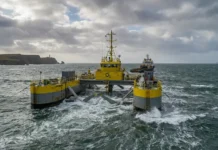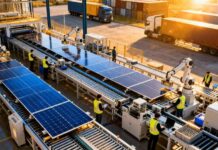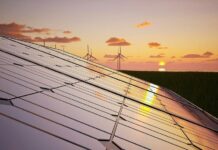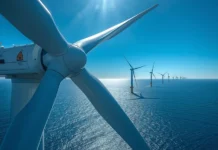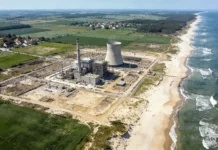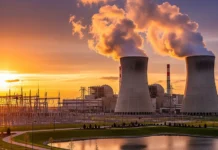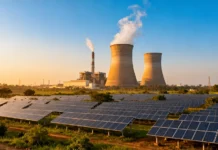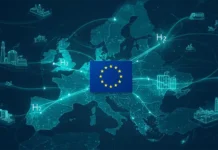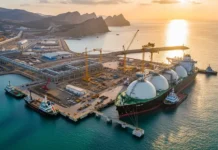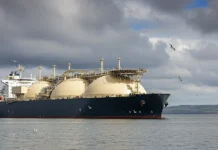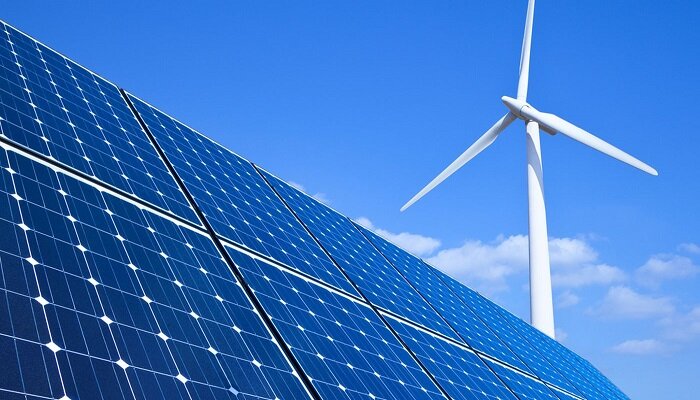Wind and solar are outpacing demand growth in the first half of 2024.
Structural growth in wind and solar was the single greatest contribution to reductions in fossil production in the EU in the first half of 2024, surpassing demand growth and lowering emissions.
In 2024, research indicated that 13 member states generated a greater amount of energy from wind and solar power compared to coal and gas for the first time.
A survey indicated that wind turbines and solar panels generated 30% of the European Union’s power in the first half of the year, surpassing fossil fuels.
Power production from coal, oil, and gas declined 17% in the first half of 2024 compared to the same time the previous year, according to climate research tank Ember. It discovered that the continuous move away from harmful fuels has resulted in a one-third reduction in the sector’s emissions since the first half of 2022.
Wind and solar increased by 45 TWh, fast enough to match and surpass new power demand, resulting in a decrease in fossil output. A closer look reveals a more permanent shift: even after accounting for variations in circumstances between the first six months of 2024 and 2023, wind and solar would have increased by 40 TWh. This exceeded the structural rise in demand (adjusted for temperature), which was 27 TWh.
As fossil fuels declined and wind and solar expanded, power sector emissions decreased by 17% in the first half of 2024 compared to the same time last year. This follows a similar 18% drop from January to June 2023. As a result, emissions in the first half of the year are currently approximately a third (-31%) lower than in the first half of 2022, marking a historic decrease in such a short time. This dip is considerably greater than the drop seen during the same times in 2020 and 2018, which represented the effect of the Covid-19 epidemic on demand. In comparison to the first half of 2017, emissions from the EU’s power industry had decreased 44%.
Wind and solar surpass fossil generation in the EU
Wind and solar power production increased, displacing fossil fuels and marking a significant milestone. In the first six months of 2024, the EU produced more power from wind and solar than from fossil fuels. They combined to produce 30% (386 TWh) of the EU’s power in the first half of 2024, with fossil production accounting for just 27% (343 TWh). Between January and June 2024, four Member States, including Germany, Belgium, Hungary, and the Netherlands, reached this milestone for the first time.
Chris Rosslowe, an Ember analyst, said that the development of wind and solar was reducing the importance of fossil fuels. They are experiencing a historic transformation in the electricity industry, which is occurring swiftly.
The analysis discovered that EU power plants burnt 24% less coal and 14% less gas from the first half of 2023 to the first half of 2024. The adjustment comes despite a minor increase in power consumption after two years of reduction due to the epidemic and the Ukraine conflict.
Rosslowe believes that if member nations can maintain momentum in wind and solar deployment, true independence from fossil fuels will become a reality.
Europe is one of the largest historical polluters, contributing to the planet-warming gas that has exacerbated severe weather, but it also has some of the most ambitious goals for cleaning up its economy. Since Russia’s invasion of Ukraine, European governments have accelerated their transition to renewables, using tougher rhetoric and looser regulatory restrictions.
However, although solar power has grown, the wind business has battled with high inflation and ongoing hostility from politicians and the public. According to the trade organization Wind generating Europe, the EU built a record 16.2GW of new wind generating capacity in 2023, but this was less than half of what was required that year to reach its climate commitments by the end of the decade.
According to scenarios developed by the Intergovernmental Panel on Climate Change (IPCC) and the International Energy Agency, the majority of the energy required to run a clean economy would be generated by sunshine beaming on panels and gusts of wind rotating turbines.
Wind and solar dominate fossil production in 13 Member States
According to the Ember study, 13 member states produced more power from wind and solar than from fossil sources during the first half of the year. The authors discovered that Germany, Belgium, Hungary, and the Netherlands were the first to reach that milestone.
Andrea Hahmann, a physicist at Denmark Technical University who co-authored an IPCC report chapter on energy systems, described the development as important but not unexpected.
According to her, strong winds were widespread in northern Europe, where the majority of wind energy is produced, during the first six months of 2024. The ‘crossing of the lines’ proves that the EU’s electrical transition is achievable, and we should not be pessimistic. The renewable energy objectives that must be fulfilled are ambitious, but attainable with the right legislative measures.
This EU milestone is not being pushed just by a few countries: nine Member States have previously produced more power from wind and solar than fossil fuels in the first six months of previous years, with wind and solar continuing to expand their advantage. Wind and solar have now outperformed fossil fuels in almost half of EU Member States. These nations account for 70% of the EU’s overall power consumption. Just five years ago, five out of 27 countries—France, Sweden, Denmark, Lithuania, and Luxembourg—accounted for barely 25% of EU power consumption.
A structural change occurs when new capacity comes online
While the amount of future fossil output reductions is unknown, major wind and solar capacity increases through 2024 suggest that this tipping point is likely to be permanent. Wind Europe estimates 15.8 GW of wind power to be constructed in the EU by 2024, while SolarPower Europe predicts 62 GW of solar capacity increases over the same time period.
Under these assumptions, wind and solar power would still outperform fossil generation in the first half of 2025, even if hydro generation reverted to its lowest output in five years and EU energy consumption increased at the highest pace in five years. Demand increased by 5.8% in the first half of 2021 as a result of the 2020 Covid-19 lockout. That pace of demand increase is unlikely to materialize in the short future, with the IEA forecasting slower growth in EU power consumption, at 2.3% per year on average between 2024 and 2026.
Further acceleration is required to continue this change
The change of the EU’s electrical grid has been rapid in recent years. Despite rising demand, fossil generation fell virtually to an all-time low in the first half of 2024. Renewables have played an important part in lowering the bloc’s high electricity costs, but maintaining the current rate of transformation will be difficult. To remove hurdles to future wind and solar deployment, specific legislative action and execution will be required.
Annual additions to EU solar capacity climbed by at least 40% or more in the three years before and including 2023. While yearly additions are likely to continue to rise, the pace of increase is expected to decline to less than 20% each year. Under the REPowerEU plan, such an increase would still be sufficient to reach the EU’s 2030 target of 750 GWdc installed capacity. However, the most recent Member State plans seek to produce just 650 GWdc by 2030, highlighting a mismatch between EU energy targets and national aspirations.
The EU’s wind capacity additions are likely to expand only after 2025, as longer project lead times imply that increasing auction volumes and investment choices in 2023 will take longer to produce bigger deployment. However, under present policy circumstances, the EU is expected to fall 30 GW short of the minimum 425 GW needed to reach its 2030 objective, and much further short of the 500 GW specified in the REPowerEU plan.
As electricity costs return to pre-crisis levels, Europe cannot depend only on the market to accelerate renewable energy development. Well-designed and executed incentive programs will be critical to maintaining pace, as seen by Germany’s outstanding solar development in 2024. Non-market impediments, such as grid capacity limits, must also be addressed. This is particularly visible in the Netherlands, where the network has struggled to keep up with the country’s solar development.
Progress has already been made in designing regulations to address these difficulties, but quicker action is required to accelerate renewables development. Ursula von der Leyen’s reappointment as President of the European Commission ensures a continuous mandate to deliver on the Green Deal’s ambitious goals, as she remains steadfastly dedicated to the EU’s leadership in climate action. The only way to further decrease Europe’s expensive dependency on fossil fueled generation and link the EU’s energy ambitions with its climate duties is via thoughtful and timely action to achieve these objectives.



